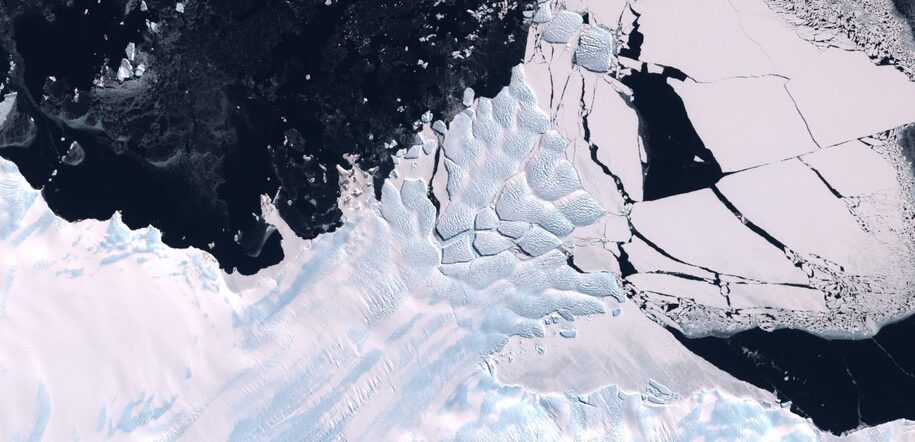A study by Copernicus reports that the effect of sea ice (fast ice connected to land) as a supporting force against land ice is negligible. The study area was the Larsen B Ice Shelf, which has been collapsing since 2002 and is effectively gone after a major collapse in 2022.
We observe the evacuation of 11-year-old land-fast sea ice in Larsen B Bay on the East Antarctic Peninsula in January 2022, which was partly driven by warm atmospheric conditions and strong winds from the coast. This sea ice evacuation was closely followed by major changes in the calving behavior and dynamics of a subset of the region’s ocean-terminating glaciers. Using satellite measurements, we show that, after a decade of gradual slowing, Hektoria, Green, and Crane glaciers accelerated by about 20%–50% between February and late 2022, with each retreating by more than 100 mine−1. Under the circumstances, this is attributable to their transition to tidewater glaciers following the loss of their ice shelves after the evacuation of landfast sea ice. However, the question remains whether landfast sea ice could have influenced the dynamics of these glaciers, or the stability of their ice shelves, through a buttressing effect similar to that of embedded ice shelves on grounded ice streams. We show, with a series of diagnostic modelling experiments, that direct landfast sea ice buttressing had a negligible impact on the dynamics of the grounded ice streams. Furthermore, we suggest that the loss of landfast sea ice buttressing could have influenced the dynamics of the rheologically weak ice shelves, which in turn would have reduced their stability over time; however, the associated shifts in the intra-shelf resistance stress distributions would have been minor. This indicates that the loss of the continental ice buttresses was likely a secondary process in the ice shelf disintegration, compared to, for example, increased ocean swell or the causes of the initial continental ice disintegration.
The break in 2002.
In the summer of 2002 in the Southern Hemisphere, scientists monitoring daily satellite images of the Antarctic Peninsula watched in amazement as nearly the entire Larsen B Ice Shelf disintegrated and collapsed in just over a month. They had never seen such a large area — 3,250 square kilometers, or 1,250 square miles — disintegrate so quickly.
The break in 2022.
Scientists are still investigating the reason for the breakup, but the early clearing of seasonal sea ice along the Antarctic Peninsula suggests that the austral summer has been warm and wet. University of Colorado, Boulder, scientist Rajashree Tri Datta noted that foehn windinfluenced by a large atmospheric river, helped to destabilize the ice sheet. The phenomenon is visible in this animation composited from images from NOAA’s GEOS-16 satellite.
AI research from the University of Cambridge has mapped slush on the surface of Antarctic ice shelves for the first time. It’s another threat to the Antarctic continent. This time, the damage is to the ice sheet itself, rather than the large chunks of decaying underside of the massive ice platforms that surround Antarctica. Using NASA satellite imagery, it was determined that meltwater lakes and slush pose a threat because of their weight, and that surface meltwater has the potential to cause hydrofracture and collapse.
Slush (water-soaked snow) accounts for more than half of all meltwater on Antarctic ice shelves at the height of summer, yet it is rarely accounted for in regional climate models.
Researchers led by the University of Cambridge used artificial intelligence techniques to map the melting snow on Antarctic ice shelves. They found that 57% of all meltwater is held as snowmelt, with the remainder in surface ponds and lakes.
As the climate warms, more meltwater forms on the surface of ice shelves, the floating ice around Antarctica that acts as a buttress against glacial ice inland. Increased meltwater can lead to instability or collapse of the ice shelf, which in turn leads to sea level rise.
The researchers also found that meltwater and accumulated meltwater lead to 2.8 times more meltwater formation than predicted by standard climate models, because it absorbs more heat from the sun than ice or snow. Resultsreported in the magazine Nature Geosciencescould have far-reaching consequences for ice shelf stability and sea level rise.
cut
“Because meltwater is more solid than ice, it won’t cause hydraulic fracturing in the same way that lake water would, but it’s certainly something we have to take into account when trying to predict how or whether ice shelves will collapse,” Willis said.
In addition to the potential implications of slush for hydrofracture, it also has a large effect on melt rates. Because slush and lakes are less white than snow or ice, they absorb more heat from the sun, leading to more snowmelt. This additional melt is currently not accounted for in climate models, which can lead to underestimates in projections of ice sheet melt and ice shelf stability.
The study can be found in Nature Geoscience.
Bob Berwyn writes in Inside Climate News:
Earlier this week, a separate study The same journal also showed the increasing vulnerability of Antarctica’s ice shelves to melting from below. The findings suggest that a warming ocean is likely to lead to ‘runaway melting’.
Damage to Thwaites Glacier continues well into the winter. In the Amundsen Sea Embayment, melting occurs year-round with open water present.
For more information:
Damage to the ice tongue of the Astrolabe Glacier (Adélie Coast, Antarctica).
Surface dynamics and calving cycle history of Astrolabe Glacier (Adélie Coast, Antarctica) derived from satellite images
From Daily Kos blogger Denise Oliver Velez.
Caribbean Affairs: The Devastating Aftermath of Hurricane Beryl
